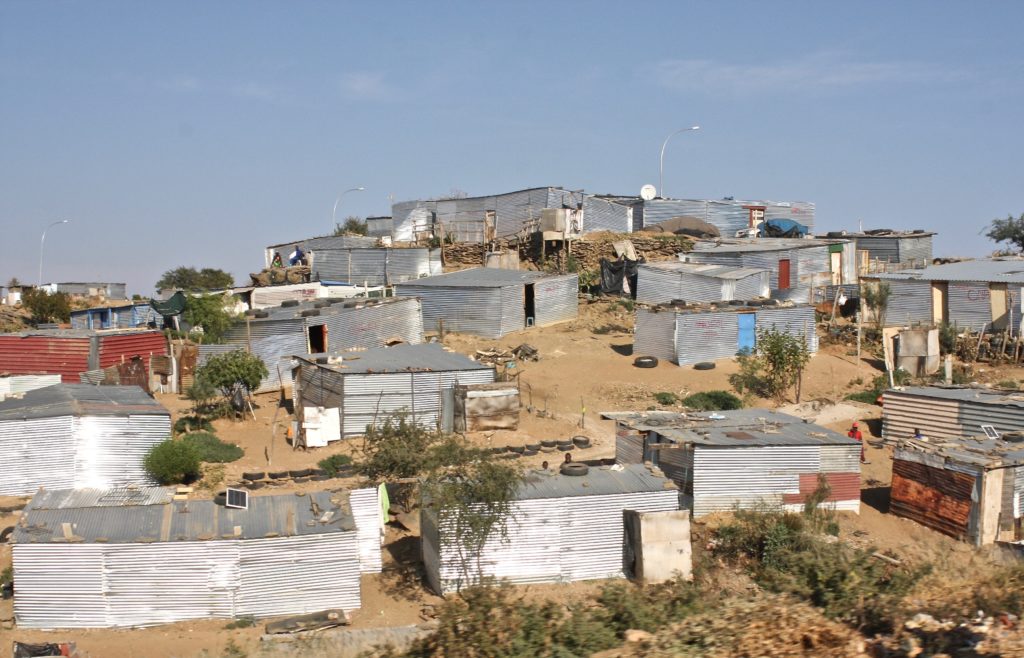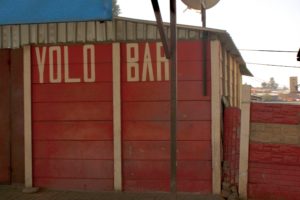Namibia has not always been the friendly, welcoming country that it is today. In fact, the late 1950s tell a time where injustice, apartheid, and rampant racial discrimination were widespread across the country. The political party that spread the apartheid idealism was responsible for the dislocation of thousands of black Namibians.
The township of Katutura was created as a haven for the black community when the apartheid regime took power and forcefully kicked them out of their houses. The restrictions imposed on the new residents of Katutura saw much resistance and opposition. They were forced to rent poorly made aluminum shacks, yet could never fully own them, and the distance from the Windhoek city center was also greatly increased.

A group of aluminium shacks within Katutura Township. These shacks serve as a meagre form of shelter for residents of this town.
It was by this effort that a vicious cycle of poverty and despair would grip an ethnic community. For almost 50% of the original population of Windhoek, they would never escape. Although apartheid ended, we still see the repercussions of these events to this day. Currently, 750,000+ citizens of Namibia are reliant on government food assistance. Without government help, these people would starve.
Over the years, the size of Katutura has increased proportionately; currently more than 50% of Windhoek’s population lives there. It appears a never-ending struggle for inhabitants in this crudely constructed, filthy, and unsafe area because of current unemployment rates over 30%. To put the vast size of this town into perspective, it is roughly the size of Bryan/College Station, with everyone in Katutura living below the poverty line.
A drive through Katutura will bring you face-to-face with the harsh realities of extreme poverty caused by unemployment and an apparent addiction to alcohol. Streets are lined with endless bars that serve residents’ desires to escape their sorrows. On the other hand, bars appear to be a main factor restricting them from leaving this way of life. The harsh pattern of alcohol and drug abuse, and poverty can be seen in the tired and worn faces of those roaming the streets.

A bright red bar constructed street side in Katutura. For many citizens of Katutura, the bottom of a bottle is the only way to escape the harsh reality surrounding them.
Because of the Land Reform Act of 2002, new residents are required to register and pay for a small parcel of land in which they may construct a meager living area. The government regularly flies overhead, snapping aerial photographs of Katutura. New structures erected without proper paperwork are promptly torn down, leaving people with nothing once again. More often than not, these newest residents moved into Katutura from a more rural region.
Despite harsh realities, the government has made improvements in Katutura over the years. New security cameras were installed along the lamp posts, water dispensing areas have been implemented, and routine trash services were added. The water dispensing stations greatly improved the quality of life because residents no longer needed to walk long distances for water. Trash services help reduce the spread of infection and diseases, even though they are not quite enough to support the large population. By midweek, trash bins can be seen overflowing with refuse, and beer bottles, which ironically are sourced from the local brewery.
With a name like Katutura, which roughly translates to “The place where people do not want to live,” this shanty town definitely lives up to its name. It will continue to take the dedicated efforts of Namibian government officials and relief organizations to figure out what must be done to make conditions more bearable for those who live here. For the current residents, it may seem like they are destined to remain in this impoverished slum for the rest of their lives.

Two young men roaming the street in Katutura city center. The rampant poverty plaguing Katutura is a direct result of the 30% unemployment rate for citizens in the 20-30 age group.
Namibia’s economy is one of the issues for many of the nation’s problems. It is at the center of focused efforts by the government and citizens alike to strengthen and grow the ecomony. There is a light, however faint, at the end of the tunnel.